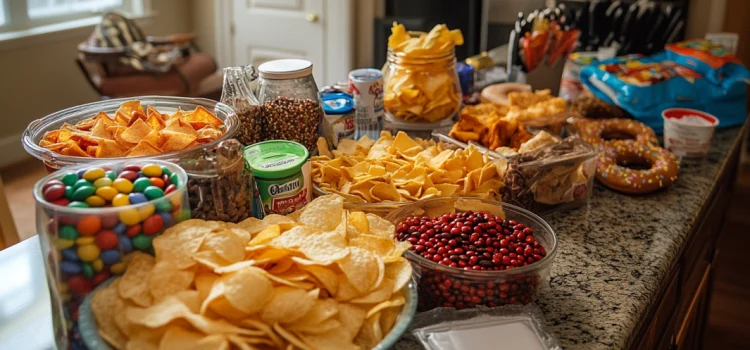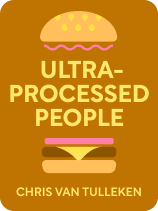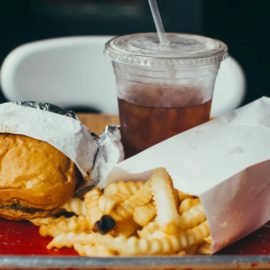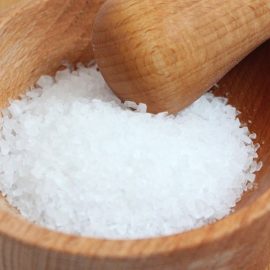

This article is an excerpt from the Shortform book guide to "Ultra-Processed People" by Chris van Tulleken. Shortform has the world's best summaries and analyses of books you should be reading.
Like this article? Sign up for a free trial here.
How are ultra-processed foods and obesity linked? In what ways can ultra-processed foods become addictive?
Dr. Chris van Tulleken, in his book Ultra-Processed People, explains how ultra-processed foods become addictive and cause us to eat more than necessary. Companies do this with tricks such as adding flavorings, softness, caloric density, and more.
Keep reading to learn why ultra-processed foods are addictive and how they affect the body.
How Does Ultra-Processed Food Cause Us to Overeat?
Van Tulleken explains that we have an internal system governing our food intake, and it’s very good at self-regulating. But UPF throws a wrench in that system, tricking us into eating more—and gaining more weight—even if we’re full or not hungry. This is why ultra-processed foods and obesity are linked.
Humans Have an Internal System to Automatically Regulate Eating
Human life is fueled by food. Our bodies have adapted over millennia to allow us to effectively consume and use the calories food provides. As a result, we have an internal system capable of automatically regulating what and how much we eat so we can obtain exactly the right amount of energy and nutrients we need to thrive.
This system comprises our stomach, liver, pancreas, small and large intestines, and other organs that transmit signals to and from the brain via various nerves, blood vessels, and hormones, constantly telling our bodies when, what, and how much to eat.
Just as we have a system that governs food intake for purposes of energy and nutrition, we also have a hedonic system, part of which governs eating purely for pleasure. One theory about why we find UPF appealing is that it causes our pleasure system to override our weight regulation system. However, an increasingly likely explanation for why we can’t stop eating UPF is that it short-circuits our weight regulation system completely.
UPF Interferes With Our Internal System by Acting Like an Addictive Substance
Van Tulleken argues that UPF is an addictive substance that deceives our brain and body into eating more of it. In this section, we’ll first examine an experiment van Tulleken conducted on himself that demonstrates how addictive UPF can be. Next, we’ll look at four characteristics of UPF that trick us into overeating: softness, calorie density, added flavorings, and additives.
Van Tulleken’s Experiment on Himself Points to UPF’s Addictiveness
Van Tulleken conducted an experiment on himself to study the effects of UPF. He began by eating no UPF for a month, and then for the next month he ate a diet consisting of 80% UPF.
Van Tulleken describes how his primarily UPF diet made him anxious, exhausted, achy, and less productive. At the end of the four weeks, he’d gained 13 pounds. Tests showed that the hormones in his body that are involved in eating weren’t functioning properly:
- the hormone that signals fullness (leptin) hardly responded to a large meal,
- the hunger hormone (ghrelin) was extremely high just after he ate, and
- the hormone that signals fat storage (also leptin) increased fivefold.
In addition, MRI scans showed increased connectivity between the parts of his brain involved in desire and reward and the parts involved in hormonal control of food intake. The brain pathways didn’t change, but the information flowing through them did—and over time, those brain circuits themselves could change, too.
All of this suggested that van Tulleken’s eating was increasingly governed by subconscious signals telling him to eat more.
Besides van Tulleken’s experiment, there are many other indications that UPF is addictive, including:
- Brain imaging shows that UPF stimulates the brain’s reward system in the same way as addictive drugs.
- People consistently score UPF higher than real food on food addiction scales.
- UPF and addictive drugs are both modified from their natural state to allow for fast, easy delivery of the rewarding substance.
- A high UPF diet causes more deaths worldwide than tobacco.
In addition, says van Tulleken, UPF has many characteristics that trick us into overeating.
UPF’s Softness Tricks Us Into Eating Faster
The chemical, physical, and heat processing UPF undergoes makes it much softer than whole foods. Softer food is easier to eat, so people eat UPF faster than other food. This means they end up eating more: Research shows that eating faster increases the risk of eating more, gaining weight, and having a metabolic disease.
Plus, our digestive system has evolved to break down the physical structure of whole foods—not to handle food so soft that it behaves in our bodies as if it’s already been chewed. The hormones that normally signal you’re full don’t know what to do with UPF. So not only is UPF’s softness causing us to eat more of it, but it’s also tricking us into not feeling full when we do.
(Shortform note: One reason UPF is so soft is that industrial processing destroys the natural fiber in foods. But fiber serves many important functions in the body. It slows digestion, reduces blood sugar spikes, delays the return of hunger after eating, and travels to the colon to nourish the microbes in the gut microbiome. As a result, people with high-UPF diets not only tend to eat more than people with diets high in unprocessed, fiber-rich foods, but they also appear to absorb significantly more calories when they eat.)
UPF’s Calorie Density Tricks Us Into Eating More
Whole foods like vegetables and meat have a high water content, but UPF needs to be dry so it doesn’t go bad. Because it lacks moisture, UPF is very dense in calories. This calorie density, when combined with softness, means that UFC will cause you to consume more calories, faster, than you would with unprocessed foods. Studies consistently show that foods with high calorie density promote eating and weight gain.
(Shortform note: In The Omnivore’s Dilemma, Pollan writes that humans have a biological preference for calorie-dense foods because our hunter-gatherer ancestors feasted whenever they could, to build fat reserves to last through future food shortages. UPF companies are taking advantage of this evolutionary preference to get us to buy and consume more.)
UPF’s Added Flavoring Tricks Us Into Thinking We’re Eating Something Nutritious
Van Tulleken says the added flavoring in UPF also tricks us into thinking we’re eating something nutritious, which may cause us to eat more. This happens because we associate certain flavors with nutritious foods, even though ultra-processing destroys the nutrients in whole foods.
When it comes to nutrition, there’s a big difference between whole foods and the components that make up whole foods. Research consistently demonstrates that eating whole foods protects against cancers, heart disease, dementia, and early death. Many studies show that nutrients like vitamins and minerals are only beneficial when consumed in whole foods containing them. When these same nutrients are consumed independently of whole foods, they’re not effective. In other words, multivitamins and supplements generally don’t work for healthy people (people without nutrient deficiencies). They don’t decrease the risk of disease or death.
The process of manufacturing UPF destroys the thousands of molecules that comprise whole foods, removing vitamins, reducing fiber and polyphenols, and generally ridding the food of micronutrients. UPF manufacturers are required by law to add certain vitamins and minerals into their food so we don’t develop deficiencies. However, the few that they add back in don’t make up for all the micronutrients lost in the course of processing. Those lost micronutrients might be precisely the ones that make whole foods so good for you.
In addition to removing micronutrients from food, ultra-processing destroys flavor molecules, so manufacturers also add in flavoring. Van Tulleken explains that added flavorings in UPF affect both smell and taste. We link smells and tastes with our past experiences with food, so these senses can signal to us how nutritious a particular food is likely to be. This means that the added flavoring in UPF may convince our brains that what we’re eating is nutritious, even if it has been stripped of all its micronutrients. In short, added flavoring in UPF may be tricking our systems of smell and taste into thinking we’re eating something nutritious.
For example, van Tulleken notes that Pringles snack chips contain the flavor enhancers glutamate, guanylate, and inosinate—molecules that normally occur in easily digestible proteins such as cooked meats. When we eat Pringles, the added flavoring signals to our brain that we’re eating something akin to a home-cooked stew. Instead, all we get is starch and fats.
Some scientists have theorized that we’re eating more in an attempt to make up for our increasing micronutrient deficiency. This may be why UPF diets can result in malnutrition and obesity simultaneously.
UPF’s Additives Damage Our Microbiome
Plus, additives in UPF may damage our microbiome, leading to overeating and other problems.
Our microbiome consists of all the microorganisms—such as bacteria, viruses, and immune cells—that live in our body, particularly in our gut. Van Tulleken calls the microbiome the body’s largest immune organ; it’s responsible for protecting us from harmful bacteria.
Manufacturers use thousands of additives in UPF, including emulsifiers, stabilizers, leavening agents, artificial sweeteners, and artificial flavors. Our gut microbiome turns some food into beneficial molecules, but food containing additives may harm the microbiome by leading to intestinal inflammation. This can result in overeating.
Even if additives don’t cause overeating, research suggests that they can alter the balance of bacteria in the gut. This imbalance can contribute to a variety of diseases, including rheumatoid arthritis, autoimmune diseases, and even cancer and mental illness.
(Shortform note: Van Tulleken only cites one study (on mice) linking additives to microbiome damage and overeating; critics note that human microbiomes are very different from the microbiomes of other animals. However, research linking microbiome damage to inflammation indicates that certain diets high in additives may cause chronic inflammation, which is associated with many serious diseases. Inflammation is your body’s immune response to a virus, bacteria, foreign toxin, or injury. Acute inflammation is a natural part of the healing process. Chronic inflammation occurs when your body continues sending inflammatory signals even when there’s no outside danger. Eating too much of certain UPF may increase chronic inflammation by causing a gut microbiome imbalance.)

———End of Preview———
Like what you just read? Read the rest of the world's best book summary and analysis of Chris van Tulleken's "Ultra-Processed People" at Shortform.
Here's what you'll find in our full Ultra-Processed People summary:
- Why it’s so hard to stop eating your favorite chips
- How the way ultra-processed food is made harms the environment
- Ways to counteract the effects of ultra-processed food






